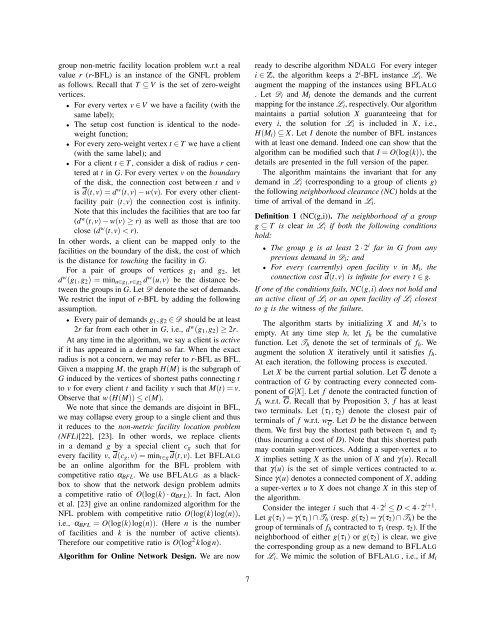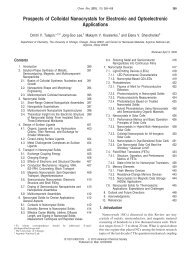Online Node-weighted Steiner Forest and ... - Duke University
Online Node-weighted Steiner Forest and ... - Duke University
Online Node-weighted Steiner Forest and ... - Duke University
Create successful ePaper yourself
Turn your PDF publications into a flip-book with our unique Google optimized e-Paper software.
group non-metric facility location problem w.r.t a real<br />
value r (r-BFL) is an instance of the GNFL problem<br />
as follows. Recall that T ⊆ V is the set of zero-weight<br />
vertices.<br />
• For every vertex v ∈ V we have a facility (with the<br />
same label);<br />
• The setup cost function is identical to the nodeweight<br />
function;<br />
• For every zero-weight vertex t ∈ T we have a client<br />
(with the same label); <strong>and</strong><br />
• For a client t ∈ T , consider a disk of radius r centered<br />
at t in G. For every vertex v on the boundary<br />
of the disk, the connection cost between t <strong>and</strong> v<br />
is d(t,v) = d w (t,v) − w(v). For every other clientfacility<br />
pair (t,v) the connection cost is infinity.<br />
Note that this includes the facilities that are too far<br />
(d w (t,v) − w(v) ≥ r) as well as those that are too<br />
close (d w (t,v) < r).<br />
In other words, a client can be mapped only to the<br />
facilities on the boundary of the disk, the cost of which<br />
is the distance for touching the facility in G.<br />
For a pair of groups of vertices g 1 <strong>and</strong> g 2 , let<br />
d w (g 1 ,g 2 ) = min u∈g1 ,v∈g 2<br />
d w (u,v) be the distance between<br />
the groups in G. Let D denote the set of dem<strong>and</strong>s.<br />
We restrict the input of r-BFL by adding the following<br />
assumption.<br />
• Every pair of dem<strong>and</strong>s g 1 ,g 2 ∈ D should be at least<br />
2r far from each other in G, i.e., d w (g 1 ,g 2 ) ≥ 2r.<br />
At any time in the algorithm, we say a client is active<br />
if it has appeared in a dem<strong>and</strong> so far. When the exact<br />
radius is not a concern, we may refer to r-BFL as BFL.<br />
Given a mapping M, the graph H(M) is the subgraph of<br />
G induced by the vertices of shortest paths connecting t<br />
to v for every client t <strong>and</strong> facility v such that M(t) = v.<br />
Observe that w(H(M)) ≤ c(M).<br />
We note that since the dem<strong>and</strong>s are disjoint in BFL,<br />
we may collapse every group to a single client <strong>and</strong> thus<br />
it reduces to the non-metric facility location problem<br />
(NFL)[22], [23]. In other words, we replace clients<br />
in a dem<strong>and</strong> g by a special client c g such that for<br />
every facility v, d(c g ,v) = min t∈g d(t,v). Let BFLALG<br />
be an online algorithm for the BFL problem with<br />
competitive ratio α BFL . We use BFLALG as a blackbox<br />
to show that the network design problem admits<br />
a competitive ratio of O(log(k) · α BFL ). In fact, Alon<br />
et al. [23] give an online r<strong>and</strong>omized algorithm for the<br />
NFL problem with competitive ratio O(log(k)log(n)),<br />
i.e., α BFL = O(log(k)log(n)). (Here n is the number<br />
of facilities <strong>and</strong> k is the number of active clients).<br />
Therefore our competitive ratio is O(log 2 k logn).<br />
Algorithm for <strong>Online</strong> Network Design. We are now<br />
ready to describe algorithm NDALG For every integer<br />
i ∈ Z, the algorithm keeps a 2 i -BFL instance L i . We<br />
augment the mapping of the instances using BFLALG<br />
. Let D i <strong>and</strong> M i denote the dem<strong>and</strong>s <strong>and</strong> the current<br />
mapping for the instance L i , respectively. Our algorithm<br />
maintains a partial solution X guaranteeing that for<br />
every i, the solution for L i is included in X, i.e.,<br />
H(M i ) ⊆ X. Let I denote the number of BFL instances<br />
with at least one dem<strong>and</strong>. Indeed one can show that the<br />
algorithm can be modified such that I = O(log(k)), the<br />
details are presented in the full version of the paper.<br />
The algorithm maintains the invariant that for any<br />
dem<strong>and</strong> in L i (corresponding to a group of clients g)<br />
the following neighborhood clearance (NC) holds at the<br />
time of arrival of the dem<strong>and</strong> in L i .<br />
Definition 1 (NC(g,i)). The neighborhood of a group<br />
g ⊆ T is clear in L i if both the following conditions<br />
hold:<br />
• The group g is at least 2 · 2 i far in G from any<br />
previous dem<strong>and</strong> in D i ; <strong>and</strong><br />
• For every (currently) open facility v in M i , the<br />
connection cost d(t,v) is infinite for every t ∈ g.<br />
If one of the conditions fails, NC(g,i) does not hold <strong>and</strong><br />
an active client of L i or an open facility of L i closest<br />
to g is the witness of the failure.<br />
The algorithm starts by initializing X <strong>and</strong> M i ’s to<br />
empty. At any time step h, let f h be the cumulative<br />
function. Let T h denote the set of terminals of f h . We<br />
augment the solution X iteratively until it satisfies f h .<br />
At each iteration, the following process is executed.<br />
Let X be the current partial solution. Let G denote a<br />
contraction of G by contracting every connected component<br />
of G[X]. Let f denote the contracted function of<br />
f h w.r.t. G. Recall that by Proposition 3, f has at least<br />
two terminals. Let (τ 1 ,τ 2 ) denote the closest pair of<br />
terminals of f w.r.t. w G<br />
. Let D be the distance between<br />
them. We first buy the shortest path between τ 1 <strong>and</strong> τ 2<br />
(thus incurring a cost of D). Note that this shortest path<br />
may contain super-vertices. Adding a super-vertex u to<br />
X implies setting X as the union of X <strong>and</strong> γ(u). Recall<br />
that γ(u) is the set of simple vertices contracted to u.<br />
Since γ(u) denotes a connected component of X, adding<br />
a super-vertex u to X does not change X in this step of<br />
the algorithm.<br />
Consider the integer i such that 4 · 2 i ≤ D < 4 · 2 i+1 .<br />
Let g(τ 1 ) = γ(τ 1 )∩T h (resp. g(τ 2 ) = γ(τ 2 )∩T h ) be the<br />
group of terminals of f h contracted to τ 1 (resp. τ 2 ). If the<br />
neighborhood of either g(τ 1 ) or g(τ 2 ) is clear, we give<br />
the corresponding group as a new dem<strong>and</strong> to BFLALG<br />
for L i . We mimic the solution of BFLALG , i.e., if M i<br />
7
















